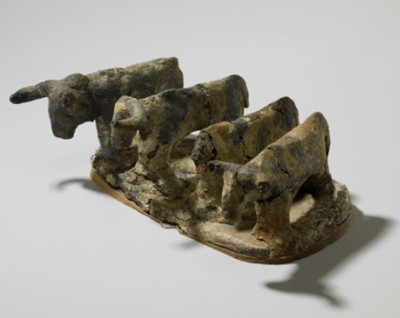The owner of our four clay cows would have been laid in an oval pit. He would have been placed in a crouched position, lying on a mat of rushes, facing the setting sun. And around him were his grave goods - items of value for his journey into the afterlife, five and a half thousand years ago; among them his four clay cows. Cow models like this one are quite common, so we can be fairly sure that cows must have played a significant part in Egyptian daily life - such an important part, in fact, that they couldn't be left behind when the owner passed through death and on into the afterlife. How did this humble beast become so important to human beings? Martin Jones, Professor of Archaeological Science at Cambridge University, is an expert in the archaeology of food:
我們這些小陶牛的墓主被長(zhǎng)眠著一座橢圓型的土坑里。他被放置成為蜷縮的姿勢(shì),躺在一張蒲草墊上,面向落日的方向。他身邊環(huán)繞著他的隨葬品,都是一些在他踏上來(lái)生旅程上可以用到的物品,而這些掩埋在五千五百年歲月塵埃中的物品,就包括他的四只小陶牛。類似的陶牛模型在那時(shí)的埃及相當(dāng)普遍,所以我們可以肯定牛在當(dāng)時(shí)人類日常生活發(fā)揮了相當(dāng)重要的作用。作用性大到,即使主人的死亡也不能使他與他的牛群分開(kāi),要一同帶往來(lái)生。那么這種不起眼的牲畜是如何變得對(duì)人類如此重要的呢?劍橋大學(xué)的考古學(xué)教授馬丁·瓊斯是食物考古專家:
If we think of the human diet in two steps - one is with early modern humans, there is an enormous adventurous diversification. We were eating everything - seeds, fish, mammoths, birds - anything that moves we are finding a way to eat it. And then there is a second episode, which starts around ten thousand years ago, where we seem to home in on a small number of target species, particularly grass seeds what we call cereals, underground tubers, and a small number of animals.'
“如果我們把人類飲食分成兩個(gè)階段,第一階段便是早期現(xiàn)代人種,當(dāng)時(shí)人類的飲食范圍真是一種龐大而冒險(xiǎn)的多樣化。幾乎什么東西都吃——種子、魚、猛犸象、鳥類等等。只要那東西會(huì)動(dòng),我們就會(huì)想方設(shè)法抓來(lái)吃。然后第二階段,大概開(kāi)始于一萬(wàn)年前左右, 我們開(kāi)始把注意力集中在種類相對(duì)較少的食物品種上,最多的是草籽,或者我們所說(shuō)的谷物,地下塊莖,還有就是極少數(shù)的動(dòng)物。












